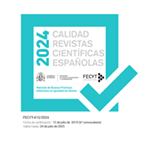Section Policies
Karpeta
This section includes papers based on original research on the complex ways in which technology and new social media reshape social, economic, political, and cultural life. Special attention is given to articles that address the growing role of technology in contexts of communication and social mobilization from a critical perspective.
Maximum length: 7,000 words, including bibliography, graphs, annexes, etc.
Miscellany
This section includes papers on technology or technoscientific issues and debates from a critical socio-cultural prism. Its breadth of "view" takes essays (and interviews) that are agile and informative snapshots of technosocial realities, without losing the rigor or analytical interest. Contributions will be evaluated by an external evaluator committee.
Maximum length: 7,000 words, including bibliography, graphs, annexes, etc.
Literature Reviews
This section invites authors to present literature reviews of thematic knowledge areas and their main debates, with a focus on the fields of scientific knowledge that are most relevant to Teknokultura (new technology, social movements, digital culture, etc.). The objective of this section is to generate practical, concise and critical summaries of these thematic areas, and to help with their dissemination.
Maximum length: 8,000 words, including bibliography, graphs, annexes, etc.
Book Reviews on recent relevant works.
Maximum length: 2,500 words, including bibliography.
Video Essays
The ‘Video Essays’ section includes original videographic work created using film, television, or other multimedia objects, that address issues relevant to Teknokultura, that is, the way in which technology and new social communication media restructure social, economic, political and cultural life. The video essays can also address the specific topics and issues approached by ongoing monographic issues. The video essay must be accompanied by a supporting written statement that articulates the aims and process of the work as well as the ways in which those aims are achieved in the audiovisual form. It should avoid reiterating the information presented in the video essay. The maximum length of the video essays is 10 minutes. The maximum length of the written statement is 500/1000 words, including bibliography (and filmography), graphics and other supplementary material
Examples of video essays (videos and written statements) are available in recent issues of the journals [In]Transition and Tecmerin whose innovative publishing multimedia practice has informed this section on video essays.
The work should not be under consideration for academic peer-reviewed publication elsewhere. Works do not need to be exclusive – that is, video essays that have circulated elsewhere (such as on video sharing sites) can be considered for publication in Teknokultura, but they should not have already been included in an academic publication. You can review the Teknokultura copyright and fair use policy.
Submission
Contributors should upload their video essay to Vimeo, preferably to a password protected page, or to Critical Commons. For the submission you will have to download and adjust to the video essays Sections Template available here. The written statement must be in accordance with the Submission and Authors Guidelines available to the authors. Should your work be accepted for publication you will eventually need to make your video public in the privacy settings in order to allow the journal to embed it, alongside the statement.
Review process
Video essays contributions will be evaluated by an external evaluator committee following a double-blind peer review process, meaning that the author’s identity and reviewer’s identity are concealed from each other. The reviews of video essays accepted for publication, provided the reviewers have given their approval, will be published as Open Peer Review (OPR). The identity of the reviewers will remain anonymous.












